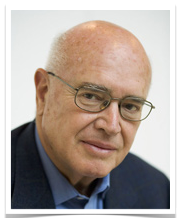Gabor A. Somorjai (born 1935) is a professor at the University of California, Berkeley in USA. He is a leading physical chemist, particularly in the field of solid state chemistry, surface science and catalysis.
- Education and Experience
1956 B.S. University of Technical Sciences, Budapest
1960 Ph.D. Physical Chemistry, University of California at Berkeley
1969 Guggenheim Fellow
1972 Unilever Professor, University of Bristol
1975 Chairman, Division of Colloid and Surface Chemistry of the ACS
1978 Miller Professor, Berkeley
- Awards and Honors
1976 Kokes Award, Johns Hopkins University
1977 Emmett Award of the American Catalysis Society
1977 Baker Lecturer, Cornell University
1979 Member, National Academy of Sciences
1981 Colloid and Surface Chemistry Award of the American Chemical Society
1983 Member, American Academy of Arts and Sciences
1986 Henry Albert Palladium Medal
1989 Peter Debye Award in Physical Chemistry of the American Chemical Society
1994 Adamson Award in Surface Chemistry of the American Chemical Society
1997 Van Hippel Award of the Materials Research Society
1998 Wolf Prize in chemistry
2000 Creative Research Award in Homogeneous and Heterogeneous Catalysis of the American Chemical Society
2000 Linus Pauling Award
2002 National Medal of Science
2006 Remsen Award from the Maryland Section of the ACS
2007 Langmuir Prize from the American Physical Society
2008 Priestley Medal
2009 Japanese Society for the Promotion of Science Award
2009 Excellence in Surface Science Award from the Surfaces in Biointerfaces Foundation
2009 Fellow of the American Chemical Society
2011 BBVA Foundation Frontiers of Knowledge Award in Basic Sciences
2011 ENI New Frontiers of Hydrocarbons Prize
2013 National Academy of Sciences Award in Chemical Sciences
- Research
Professor Somorjai’s research interests are in the field of surface science. His group is studying the structure, bonding, and reactivity at solid surfaces on the molecular scale. This knowledge is then utilized to understand macroscopic surface phenomena; adsorption, heterogeneous catalysis, and biocompatibility on the molecular level. To this end, he also develops instruments for nanoscale characterization of surfaces. These include sum frequency generation surface vibrational spectroscopy (SFG) and high pressure scanning tunneling microscopy (high pressure STM) and high pressure X-ray photoelectron spectroscopy (ambient pressure XPS).
Since 1965, Professor Somorjai has proposed, planned, and carried out a program to build the fundamental molecular basis for the surface science of heterogeneous catalysis. He characterized the structure of clean metal single crystal surfaces and determined the structure and bonding of adsorbed molecules, and used them as model catalysts. He synthesized and characterized metal and bimetallic nanoparticles in the 1-10 nm range and also used them as model catalysts as two-dimensional deposits or in three-dimensional form supported on mezoporous oxide or polymer surfaces and carried out catalytic reactions on these surfaces. He developed much of the instrumentation necessary for studying molecular surface chemistry and catalysis at high reactant pressures (atmospheres) on the small area crystals and nanoparticles. These include high pressure reaction cells that are combined with ultra high vacuum surface characterization chambers, sum frequency generation (SFG) vibrational spectroscopy, and scanning tunneling microscopy (STM), which can be used to monitor surfaces under reaction conditions, in situ. X-ray spectroscopy techniques that are synchrotron-based (ambient pressure XPS, NEXAFS and EXAFS) are also employed to monitor surfaces under reaction conditions. The reactions studied include hydrocarbon conversion and found that catalytic selectivity depends on metal nanoparticle size and shape. Small metal nanoparticles were found to be able to hetrogenize homogeneous solution phase catalytic reactions. Solid-liquid biointerfaces are studied to determine the structures of amino acids and peptides. Professor Somorjai has educated a generation of leading scientists in the field. Out of more than 130 Ph.D. students and 200 Posdoctoral Fellows, about 100 hold faculty positions.
- Representative Publications
[1] Kesmodel, L. L.; Dubois, L. H.; Somorjai, G. A. Chem. Phys. Lett. 1978, 56, 267. doi:10.1016/0009-2614(78)80236-X
- Related Links
The Somorjai Group
Gabor A. Somorjai - Wikipedia
Molecular Chemistry And Catalysis By Surfaces(C&EN)
- Photo Gallery
- Related Books
[amazonjs asin=”B00FAEG99M” locale=”US” title=”An American Scientist: The Autobiography of Gabor A. Somorjai with Mitch Jacoby”][amazonjs asin=”B005CD7864″ locale=”US” title=”Introduction to Surface Chemistry and Catalysis”][amazonjs asin=”3527331247″ locale=”US” title=”Nanomaterials in Catalysis”]
- Related Movies








